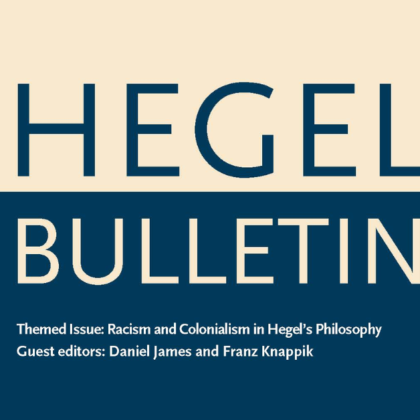Hegel in Kyoto
Why is there something rather than nothing? The fact of existence cannot be explained by an appeal to any beings, since this would assume what it wants to prove. Nishida Kitarō, the Japanese philosopher and founder of the Kyoto School, therefore proclaimed that only nothingness can be the ultimate source of existence.
What is this nothing, however? For Nishida, it is the place (Basho) of absolute nothingness—a nothingness that is beyond all beings. Articulated this way, absolute nothingness can be nothing other than a self-contradictory identity: it is the being beyond all beings. But how can something come from nothing? In The Logic of the Place of Nothingness and the Religious Worldview, Nishida argues that only a paradoxical logic can account for the existence of the world.
Hegel asserted a profound influence on Nishida’s philosophy. Nishida wrote that Hegel’s thinking was closer to his own than that of any other philosopher, and at various points in his career appropriates Hegelian terms and formulae such as ‘concrete universal,’ ‘dialectic’ and ‘negation of negation.’ In his Basho Nishida proclaims that awareness of the truth of contradiction permeating all things demands an appeal to Hegel’s theory of conceptual knowledge. Nishida found a kindred spirit in Hegel, who in his Science of Logic proclaimed every concept to be contradictory.
Tosaka Jun would even claim that Nishida deepened the tradition of German Idealism by expressing it in its purest form. To the iconic three figures of the tradition, Fichte, Schelling, and Hegel, we ought to add a fourth: Nishida. Following Tosaka, we can ask: does Hegelian philosophy find its fulfillment in Kyoto?
Tosaka, in his polemics against Nishida, certainly over-simplified Nishida’s philosophy. Nishida’s philosophy is not a repetition of Hegel, but integrates Hegelian concepts in order to transcend them. Nishida shares Hegel’s profound insight that the existence of beings can only be explained if one begins without any foundations. For Nishida, however, this demand can only be fulfilled if one begins from nothing—not being. As is typical of the Kyoto School, Nishida creatively integrates elements of many philosophical and religious traditions beyond Hegel, from Neo-Kantianism to Daoism and Zen.
Tanabe Hajime, another prominent figure of the Kyoto School, developed his own unique paradoxical logic. Despite his various disagreements with Nishida and Hegel, Tanabe too would admit that it was Hegel who inspired his own concept of paradoxical logic. However, while Hegel insisted on the unlimited power of the concept to account for all things, Nishida and Tanabe’s paradoxical logics protested that the trans-conceptual both condition and thoroughly permeate everything conceptual. Nishida and Tanabe were not wrong to invoke Hegel as inspiration for the questions that haunted them. In Hegel’s Foundation Free Metaphysics I defend the view that Hegel advances a logic of self-contradiction in order to account for the very existence of the world. In short, Hegel in Kyoto teaches us that a path to an inter-cultural philosophy can be forged without forsaking the sacred vocation of philosophy to contemplate the Absolute.







I’m just an amateur thinker, but I totally agree with Nishida Kitaro that “only nothingness can be the ultimate source of existence.” But, this isn’t a contradiction and it’s not that something comes from nothing. Instead “nothing” and “something” are just two different ways of describing the same situation, which is the situation we have traditionally thought of as “nothing”. Asking the question “Why is there something rather than nothing?” is like saying you start with a 0 (e.g., “nothing”) and end up with a 1 (e.g., “something”). As we know, 0 can’t be changed into a 1, so the only way to start with 0 and end up with a 1 is if that 0 weren’t really a 0 but was actually a 1 in disguise. I think this is the only possibility if you start with 0 and end up with 1.
How can nothing and something be one and the same? I approach this by trying to figure out why a “normal” thing like a book exists and then applying the answer to what I define as nothing. Very briefly, I think a thing exists if it’s a grouping. A grouping ties stuff together into a new unit whole. This grouping together provides a surface, or boundary, that defines what is contained within and that gives “substance” and existence to the thing. This idea of a grouping or a unity being the essence of a thing isn’t new.
Next, apply this definition to nothing. I define nothing as the lack of all matter, energy, time, space/volume, laws of physics/math/logic, abstract concepts, possibilities and possible worlds, and the lack of all minds to consider this supposed lack of all. Once everything is gone, and the mind is gone, this situation, this “absolute lack-of-all”, would be it; it would be the everything. It would be the entirety, or whole amount, of all that is present. Is there anything else besides that “absolute nothing”? No. It is “nothing”, and it is the all. An entirety, whole amount or “the all” is a grouping that defines what is contained within (e.g., everything), which, by the above definition of an existent entity, means that the situation we previously considered to be “absolute nothing” is itself an existent entity. The entirety/whole amount/”the all” grouping is itself the surface, or boundary, of this existent entity. Said another way, by its very nature, “absolute nothing”/”the all” defines itself and is therefore the beginning point in the chain of being able to define existent entities in terms of other existent entities. What this means is that “something” is necessary, or non-contingent, because even what we previously, and incorrectly, visualized as the lack of all existent entities, or “nothing”, is a “something. While this is not a new idea, a physical mechanism for how this can be is new.
So, I do think Nishida Kitaro is correct but I don’t think it’s a contradiction. I think it’s just a misunderstanding based on different ways of thinking about the situation we have usually called “nothing”.